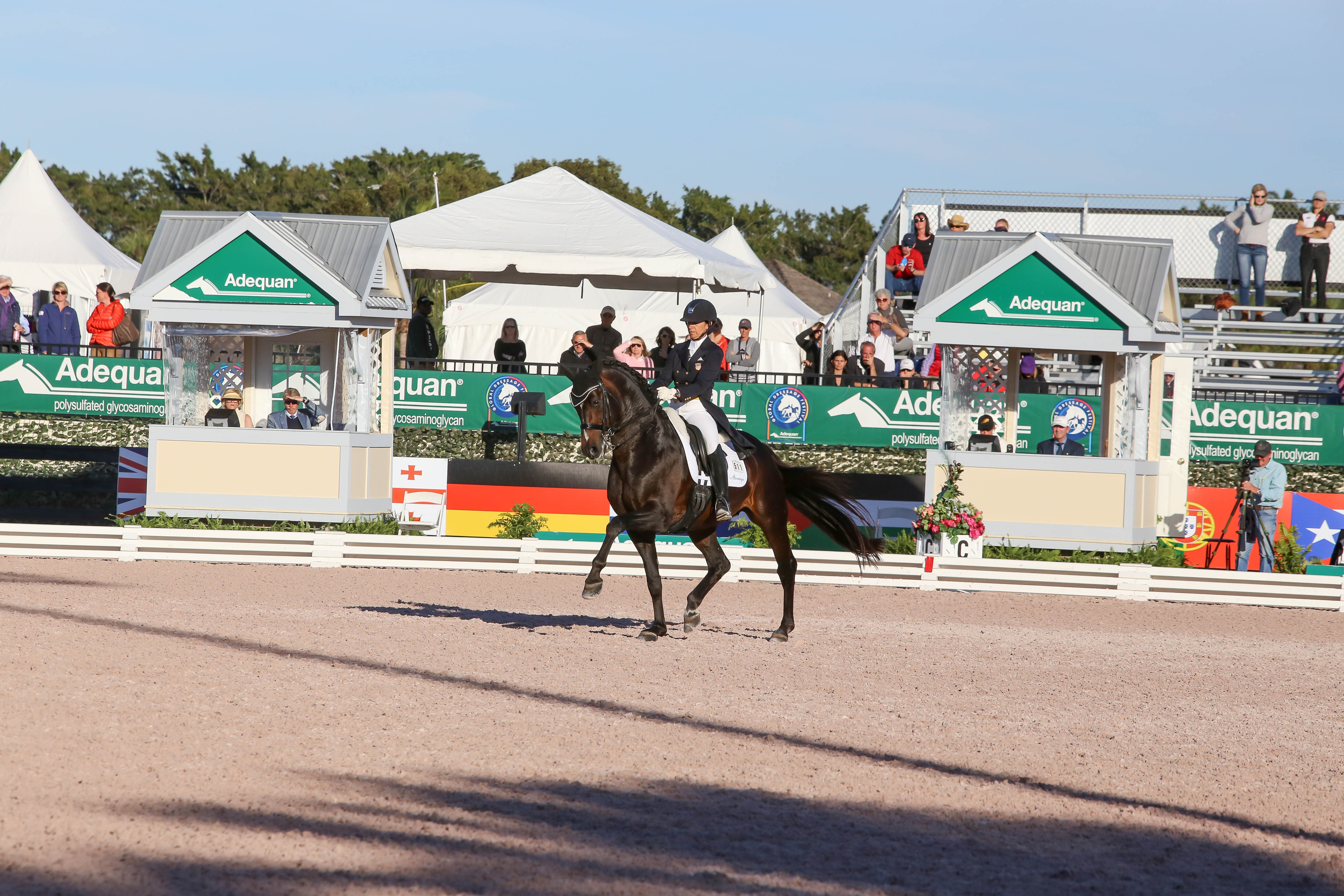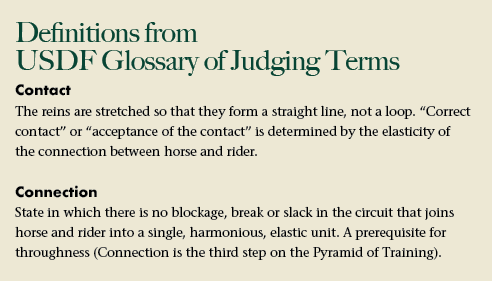We have all heard that you should ride the horse from back to front. How does the position of your arms allow this to happen? When you are riding, all your joints should be supple and movable.

of her so she can move elastically and follow the horse’s mouth with
bent arms. (Credit: Annan Hepner
)
As an Amazon Associate, Dressage Today may earn an affiliate commission when you buy through links on our site. Products links are selected by Dressage Today editors.
The bend in the elbow allows elasticity forward and backward to follow the horse’s mouth every step. In the walk and canter, the horse biomechanically has to move the neck forward and back. Creating this elastic connection means you’re not holding the horse on the bit—pulling his head down and holding it there. You are riding him out to the bit and on the bit.
Many people unintentionally ride with a straight or rigid arm. This causes a braced and backward contact with the horse’s mouth because the arm can’t follow the horse’s head and neck. If the rider’s arm is rigid with a straight elbow, all the weight of the contact is in the rider’s hands and forearms, and the horse can’t properly respond to the rein aids. With a straight arm or a stiff arm, you lose the ability to separate the rein aids from the seat and leg aids because the stiffness connects the arm and the body. This stiff connection to the mouth causes the horse to not move the neck freely forward and back and therefore, he can’t yield in the neck, poll and jaw.
Correct Contact & Connection
The ideal contact has a comfortable weight in the hands. It should feel like when you hold someone’s hand. They’re not gripping you to death or jerking you. They’re just holding you and leading you as you walk down the street. You feel they are gently there, but they’re not disturbing you.
The exact weight you should have in the hand varies from horse to horse. Some horses don’t want to take the contact, so you must encourage them to move into the connection. On the other hand, some horses are heavy and you may need to be more elastic so they have nothing to lean on. The contact may also change depending on what phase of the training session you’re in.
To find the connection, the horse must accept your rein, seat and leg aids. Use your calves to lift his back up. You should feel his withers rise and his neck drop in a relaxed manner. The horse should be on the vertical as he reaches for the bit. Ideally, you create a wheel of energy that gets pushed through from the hind end, over the back and to the bit. The energy travels around the wheel to be recycled again, so you feel that you close the leg and push the horse into the hand until you have a positive contact, which is enough weight to gently pull your arm forward but not enough to pull you out of the saddle.

Following, Flexion & Half Halts
Keep your hands in front of you and make a work space in front of the saddle to move elastically and follow the horse’s mouth forward and back with bent arms. The elbows should be bent and close to the body (but not behind the it) with your hands square in front of you. The supple arms allow the horse’s head and neck to move freely and allow you to keep your seat correctly in the saddle.
One quality you can copy from watching a talented rider in the sitting trot is she often looks like her hands are going up and down a bit each step. She has a soft contact that allows her body to sink down in each step to follow the horse. In the walk and canter, the hands move forward and back. The elasticity in the arm allows the horse’s whole body to move freely through into the connection.
To flex the horse, you have the possibility to lift, open the rein slightly or drop the hand down but always with the leverage that comes from working from the elbow and not just from the forearm and the hand. The elbow works as a lever on the poll, mouth and jaw to help flex the horse without pulling the neck shorter or creating a backward pull.
With the bent elbow, you can also be much more effective when you half halt. When I close my outside fist for the rein aid of the half halt, I am not using only my hand. Because the elbow is now momentarily fixed, the horse feels me tighten my core and use my seat in that moment. If the rider instead uses a stiff, straight arm that pulls back, the horse not only cannot feel the seat, but the mechanics of the stiff arm and inelastic connection will pull the rider out of the saddle. If you lose your seat, you cannot create an effective half halt.
Try This
Pick up the reins from the free walk and develop contact with the horse. The horse should be willing to relax his poll, neck and jaw when you pick up the reins for the first time or after a break. Show a gentle forward and backward movement of the arm with the horse’s neck to follow the motion. Imagine that if I cut the bridle off, you must follow the horse’s mouth to keep the bit there in the right way. You don’t hold the reins tightly or let them hang loose.
If, in the medium walk, the reins shorten and there is no movement in the arm, then you’ll see how short-strided the horse becomes. The stiff arm restricts him and his stride shortens, his back drops and he pulls on the rider in an inadvertent way because he wants to protect his own body from a stiff arm.
The goal is to ride the horse out to the bit and have a round horse balanced longer in front of you and shorter behind you, as opposed to a horse who is short and low in front and therefore out behind. Only then can you shift the weight when you develop collection and the front end can come up, like a speed boat coming out of the water.
Allison Brock is the head trainer at DeerMeadow Farms. She was the Reserve Grand Prix team rider for the U.S. Pan American Games in 2015 and part of the bronze-medal dressage team at the 2016 Rio Olympic Games. Currently she is the equestrian representative for the Athlete Advisory Council, which works with the U.S Olympic Committee. Brock is based in Wellington, Florida, and Keswick, Virginia.











